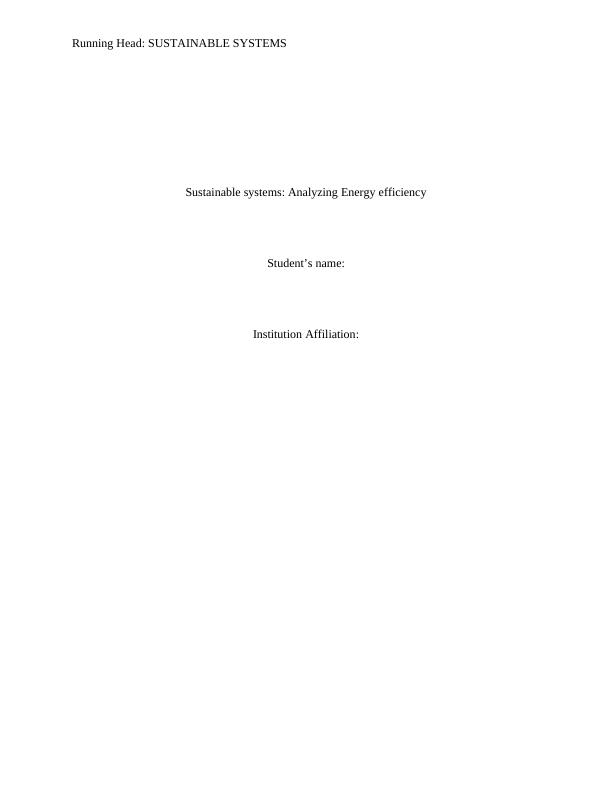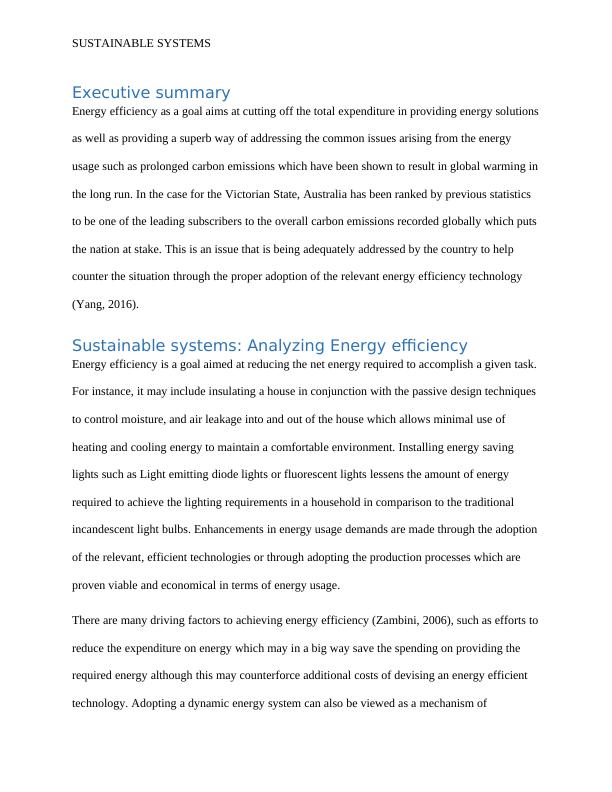Sustainable Systems Assignment
13 Pages2968 Words104 Views
Added on 2020-05-11
Sustainable Systems Assignment
Added on 2020-05-11
ShareRelated Documents
Running Head: SUSTAINABLE SYSTEMS
Sustainable systems: Analyzing Energy efficiency
Student’s name:
Institution Affiliation:
Sustainable systems: Analyzing Energy efficiency
Student’s name:
Institution Affiliation:

SUSTAINABLE SYSTEMS
Table of Contents
Executive summary.........................................................................................................................2
Sustainable systems: Analyzing Energy efficiency.........................................................................2
Energy efficiency in a household setting.........................................................................................3
A review of energy usage in the State of Victoria, Australia..........................................................4
Organizations in Australia promoting energy efficiency.................................................................5
Regulatory, social, financial, and marketing attempts in reducing the energy consumption..........5
Opportunities which decrease energy consumption........................................................................6
Cost-benefit analysis for the use of energy-efficient light globes...................................................7
References........................................................................................................................................9
Table of Contents
Executive summary.........................................................................................................................2
Sustainable systems: Analyzing Energy efficiency.........................................................................2
Energy efficiency in a household setting.........................................................................................3
A review of energy usage in the State of Victoria, Australia..........................................................4
Organizations in Australia promoting energy efficiency.................................................................5
Regulatory, social, financial, and marketing attempts in reducing the energy consumption..........5
Opportunities which decrease energy consumption........................................................................6
Cost-benefit analysis for the use of energy-efficient light globes...................................................7
References........................................................................................................................................9

SUSTAINABLE SYSTEMS
Executive summary
Energy efficiency as a goal aims at cutting off the total expenditure in providing energy solutions
as well as providing a superb way of addressing the common issues arising from the energy
usage such as prolonged carbon emissions which have been shown to result in global warming in
the long run. In the case for the Victorian State, Australia has been ranked by previous statistics
to be one of the leading subscribers to the overall carbon emissions recorded globally which puts
the nation at stake. This is an issue that is being adequately addressed by the country to help
counter the situation through the proper adoption of the relevant energy efficiency technology
(Yang, 2016).
Sustainable systems: Analyzing Energy efficiency
Energy efficiency is a goal aimed at reducing the net energy required to accomplish a given task.
For instance, it may include insulating a house in conjunction with the passive design techniques
to control moisture, and air leakage into and out of the house which allows minimal use of
heating and cooling energy to maintain a comfortable environment. Installing energy saving
lights such as Light emitting diode lights or fluorescent lights lessens the amount of energy
required to achieve the lighting requirements in a household in comparison to the traditional
incandescent light bulbs. Enhancements in energy usage demands are made through the adoption
of the relevant, efficient technologies or through adopting the production processes which are
proven viable and economical in terms of energy usage.
There are many driving factors to achieving energy efficiency (Zambini, 2006), such as efforts to
reduce the expenditure on energy which may in a big way save the spending on providing the
required energy although this may counterforce additional costs of devising an energy efficient
technology. Adopting a dynamic energy system can also be viewed as a mechanism of
Executive summary
Energy efficiency as a goal aims at cutting off the total expenditure in providing energy solutions
as well as providing a superb way of addressing the common issues arising from the energy
usage such as prolonged carbon emissions which have been shown to result in global warming in
the long run. In the case for the Victorian State, Australia has been ranked by previous statistics
to be one of the leading subscribers to the overall carbon emissions recorded globally which puts
the nation at stake. This is an issue that is being adequately addressed by the country to help
counter the situation through the proper adoption of the relevant energy efficiency technology
(Yang, 2016).
Sustainable systems: Analyzing Energy efficiency
Energy efficiency is a goal aimed at reducing the net energy required to accomplish a given task.
For instance, it may include insulating a house in conjunction with the passive design techniques
to control moisture, and air leakage into and out of the house which allows minimal use of
heating and cooling energy to maintain a comfortable environment. Installing energy saving
lights such as Light emitting diode lights or fluorescent lights lessens the amount of energy
required to achieve the lighting requirements in a household in comparison to the traditional
incandescent light bulbs. Enhancements in energy usage demands are made through the adoption
of the relevant, efficient technologies or through adopting the production processes which are
proven viable and economical in terms of energy usage.
There are many driving factors to achieving energy efficiency (Zambini, 2006), such as efforts to
reduce the expenditure on energy which may in a big way save the spending on providing the
required energy although this may counterforce additional costs of devising an energy efficient
technology. Adopting a dynamic energy system can also be viewed as a mechanism of

SUSTAINABLE SYSTEMS
minimizing the carbon emissions. Improved efficient energy in structures as well as in
transportation could in a significant way lower the world’s energy needs by one third according
to IEA in 2050 and also help in curbing the global emissions of the greenhouse gases.
The most commonly employed tools in an attempt to achieve energy efficiency include the use
of renewable energy sources and is a high priority in the sustainable energy ranking. Energy
efficiency in some countries has been proven to a national security benefit because it can be
devised as a means of minimizing the energy shipping in from other nations and may lower the
tempo at which the domestic energy resources are exploited.
Energy efficiency in a household setting
In a living premise such as a household, energy efficiency can be taken as a goal to minimize
energy usage and save on the extra spending which could otherwise be incurred if no energy
saving modes were deployed (Palm, 2011). The possible manners in which the energy is used in
a household include but are not limited to; dishwashing, clothes washing and dryers, freezers,
ovens, stoves, gas cookers, lighting, powering electrical equipments such as electrical cookers
such as induction cookers, televisions, fans, iron boxes, water heaters, mobile phones, radios and
others.
Some of the appliances proven to have a prolonged run energy consumption include the clothes
dryers and refrigerators. Installing clothesline can to a large extent reduce the energy
consumption as the dries use will be minimal. The modern energy-saving refrigerators, for
instance, use 45% lesser power more than the traditional designs in the start of the twentieth
century. This led to households change in their approach towards electrical appliances to more
modernized new ones; for example in Europe, 20 billion kWh of electricity would be stockpiled
every year, which in turn would lower the Carbon dioxide emission by approximately 17 billion
minimizing the carbon emissions. Improved efficient energy in structures as well as in
transportation could in a significant way lower the world’s energy needs by one third according
to IEA in 2050 and also help in curbing the global emissions of the greenhouse gases.
The most commonly employed tools in an attempt to achieve energy efficiency include the use
of renewable energy sources and is a high priority in the sustainable energy ranking. Energy
efficiency in some countries has been proven to a national security benefit because it can be
devised as a means of minimizing the energy shipping in from other nations and may lower the
tempo at which the domestic energy resources are exploited.
Energy efficiency in a household setting
In a living premise such as a household, energy efficiency can be taken as a goal to minimize
energy usage and save on the extra spending which could otherwise be incurred if no energy
saving modes were deployed (Palm, 2011). The possible manners in which the energy is used in
a household include but are not limited to; dishwashing, clothes washing and dryers, freezers,
ovens, stoves, gas cookers, lighting, powering electrical equipments such as electrical cookers
such as induction cookers, televisions, fans, iron boxes, water heaters, mobile phones, radios and
others.
Some of the appliances proven to have a prolonged run energy consumption include the clothes
dryers and refrigerators. Installing clothesline can to a large extent reduce the energy
consumption as the dries use will be minimal. The modern energy-saving refrigerators, for
instance, use 45% lesser power more than the traditional designs in the start of the twentieth
century. This led to households change in their approach towards electrical appliances to more
modernized new ones; for example in Europe, 20 billion kWh of electricity would be stockpiled
every year, which in turn would lower the Carbon dioxide emission by approximately 17 billion

End of preview
Want to access all the pages? Upload your documents or become a member.
Related Documents
Improving Energy Efficiency: Analysis of Household and Possible Alternativeslg...
|12
|3174
|193
Environmental Management for Sustainable Developmentlg...
|11
|1545
|399
Development of Sustainable Home using Net Zero Energylg...
|38
|5180
|483
Environmental Sustainability in Construction - Doclg...
|9
|2386
|47
Rescuing the planet from Global Warminglg...
|4
|748
|124
Australia’s Stand on Renewable Energylg...
|5
|1471
|348
